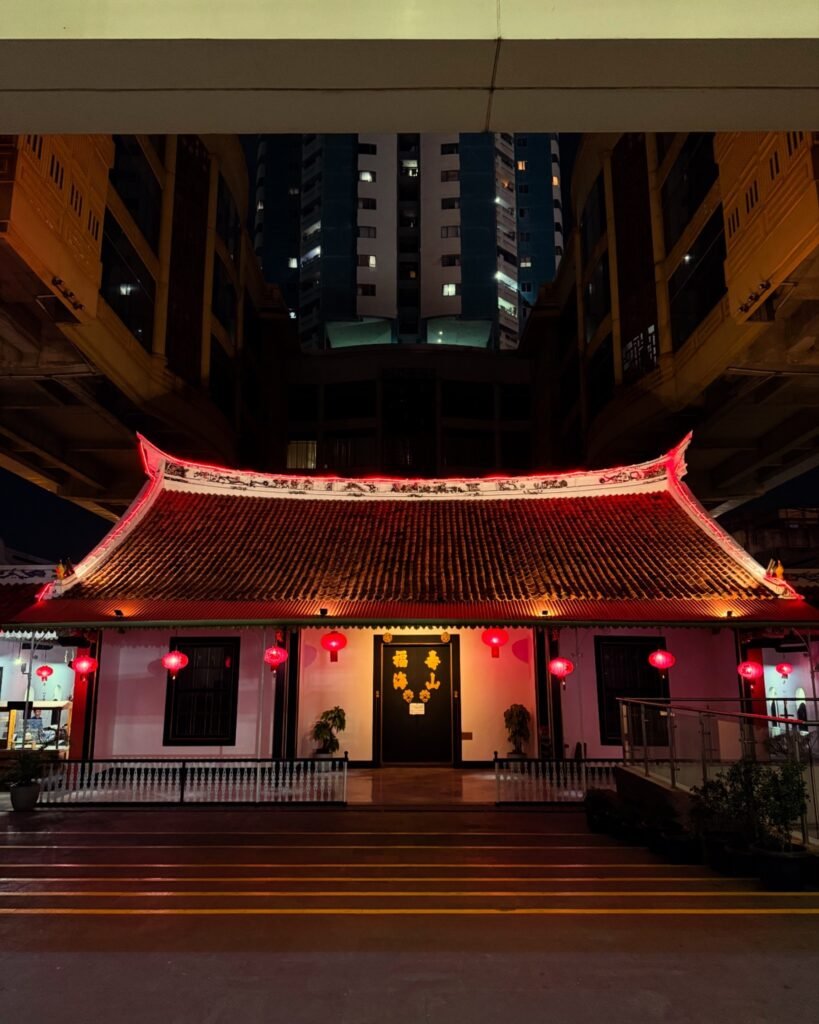Jakarta wakes up in fragments—car horns in the distance, the clatter of food carts setting up, the warm hush of early sunlight on concrete. I was already stirring before the alarm, the soft hum of the air-conditioning in my room at the Novotel Gajah Mada keeping the heat at bay. It’s not the flashiest hotel in town, but there’s something solid and familiar about it. The rooms are clean, the beds comfortable, and the location is practically unbeatable if you’re planning to explore Glodok, the city’s old Chinatown. For a few extra dollars, the Holiday Inn just a few doors down offers a sleeker, more modern experience, but Novotel feels like an old reliable friend that doesn’t need to impress to be appreciated.
Stepping out the main entrance, I was greeted immediately by a slice of history—Candra Naya. It’s literally right outside the front door, tucked between the glass towers of modern Jakarta. The contrast is striking. Candra Naya is a preserved Chinese-style mansion, once the home of Khouw Kim An, the last Chinese Major (Majoor der Chinezen) of Batavia. Built in the late 1800s and occupied through the early to mid-1900s, it was a political, social, and cultural hub for the Chinese-Indonesian community. The Dutch colonial government recognized Chinese leaders like Khouw Kim An to manage their community, and this house was a symbol of that era. Its curved rooflines, delicate woodwork, and tranquil courtyard are now framed by the steel skeletons of city development, but step inside and time feels like it slows. It’s a beautiful photo spot, no doubt, but it’s also one of the rare places in Jakarta where history is allowed to just exist quietly.

After soaking in that morning stillness, I turned onto Jalan Gajah Mada and walked down into the heart of Glodok, under the unmistakable Glodok arch. Here, the sidewalks are alive with vendors laying out their goods—herbal medicines, old coins, temple incense, random electronics, and steaming trays of Chinese-Indonesian street food. There’s a constant buzz, the kind that fills every corner with life. The air smells like soy sauce, motorbike exhaust, and ripe fruit, and there’s always something to see: tiny shrines tucked into walls, old women gossiping behind baskets of fruit, repairmen hunched over radios or tangled phone chargers.
My next stop was Djauw Coffee, a little café that manages to blend heritage and curiosity into a single space. The building it occupies used to be an old storehouse, and the owner decided to preserve much of its rustic charm—bare brick, wood beam ceilings, mismatched furniture. The shop has been quietly gaining a cult following, especially for one reason: the Turkish coffee. Right outside the entrance, a man stands behind a brass sand heater, preparing coffee the traditional way—heating cezves in hot sand until the brew bubbles over. It’s a slow, deliberate process, and people line up just to watch. Phones are always out, recording every swirl, every pour. Kids point. Tourists whisper. Locals order their regulars while glancing over their shoulders to check the spectacle. I had a cup made that way—thick, muddy, intense—and sat near the window watching the morning scene unfold. Inside, the vibe is casual and a bit nostalgic, with vintage Chinese posters and soft jazz playing over the speakers. I ordered a second round, this time an iced cappuccino, just for balance.
Recharged, I wandered deeper into the maze of alleys and corridors that make up the Petak Sembilan area. The deeper you go, the more layered it gets. Temples, wet markets, hidden noodle shops—each turn seems to offer something unexpected. Eventually, I found my way to Pantjoran Tea House, an iconic building located right at the Pantjoran intersection, easily recognized by its colonial-era façade with red shutters and the constant flurry of people coming and going.
Pantjoran has its own rich story. The building dates back to the early 1900s, originally functioning as a pharmacy during the Dutch East Indies era. After years of neglect, it was restored and transformed into the teahouse it is today—a cultural bridge between past and present. The moment you step in, you’re greeted by an elegant, serene atmosphere. Red lanterns hang from the ceiling, traditional music plays gently, and every corner has a sense of deliberate calm. The tea menu is vast—Chinese black, oolong, jasmine, pu-erh—and the staff offer suggestions if you’re unsure. I chose a chrysanthemum blend that came in a glass pot, delicate yellow petals blooming slowly in the water.
You can sip your tea while watching the world move outside—motorbikes weaving through traffic, street vendors calling out their wares, children darting between adults with reckless confidence. It’s a perfect contrast to the serenity of the teahouse, a reminder that Glodok is a place where past and present don’t just sit side by side—they fold into each other.
By the time I left Pantjoran, the sun had climbed higher, and the heat had settled over the streets like a heavy curtain. My legs were starting to feel the morning’s wandering, and the idea of a cool room and drawn curtains back at the Novotel suddenly became very appealing. I retraced my steps, a little slower this time, letting the city wash over me one more time before I returned to the comfort of air-conditioning and quiet.
There’s something deeply satisfying about exploring on foot—seeing the city not through a window, but through your senses. The noise, the smells, the textures of Glodok stay with you long after you’ve rinsed the sweat from your back. Back in my room, curtains drawn against the midday sun, I sank into the bed, already replaying the morning’s journey in my mind. Not a grand adventure, perhaps, but one of those quiet, layered experiences that cities like Jakarta offer so generously—if only you’re willing to walk a little.